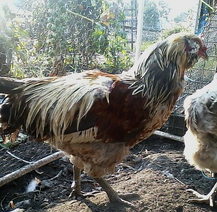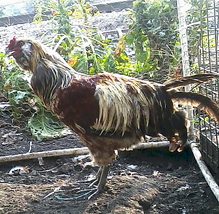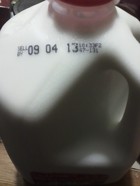I also don’t know for certain how long he was hanging there, which was a bit scary to think about last night. I left home for work yesterday morning at about 7:30 and all was well then. I did not get back home until almost 9:00pm however. I was doing my evening critter check when I discovered him hanging upside down, from one leg, because the rope was wrapped around it.
The poor guy was understandably a bit woozy. He really didn’t seem to be in much distress however. I’m not sure whether he had been hanging there long enough to give up, or if maybe he had calmed down because it was dark, or maybe he was actually cool with “hanging out” in that position. I know most chickens can be put into sort of a trance when held upside down by their feet, but one would think that hanging like that for a while would still be upsetting. He didn’t squawk or fuss when I rescued him. I offered him fresh water and he did not protest me dipping his beak, but he didn’t want a drink either (that alone makes me think he was not there for hours). He had no feeling in that leg however, so I rubbed it some to help the circulation and put him to bed for the night.
This morning’s check brought good news. He was very much able to get where he wanted to go, and could stand on both legs for short periods of time. He has a terrible limp, and I think it may take a few days for the affected leg to fully recover, but I believe he is going to be fine. I have removed the “dangerous” rope so that he, nor any of his hens, can entangle themselves again. I’m not sure what I’ll do about hanging the auto-feeder once it is repaired, but I’m open to suggestions!
***Update***
I checked on the rooster again this evening and, as you can see from the photos below, he is doing much better. He still has a noticeable limp, but he is standing for long periods of time, like any normal chicken. I'm convinced he will continue to improve, and be back to his old self within just a few days. And the girls may get a reprieve during that time as well!
None of the information contained on this site is intended to diagnose, treat, or otherwise substitute for the care and advice from a qualified human or animal medical professional. Please consult the trusted medical professional of your choice before using any of the information contained on this site.




